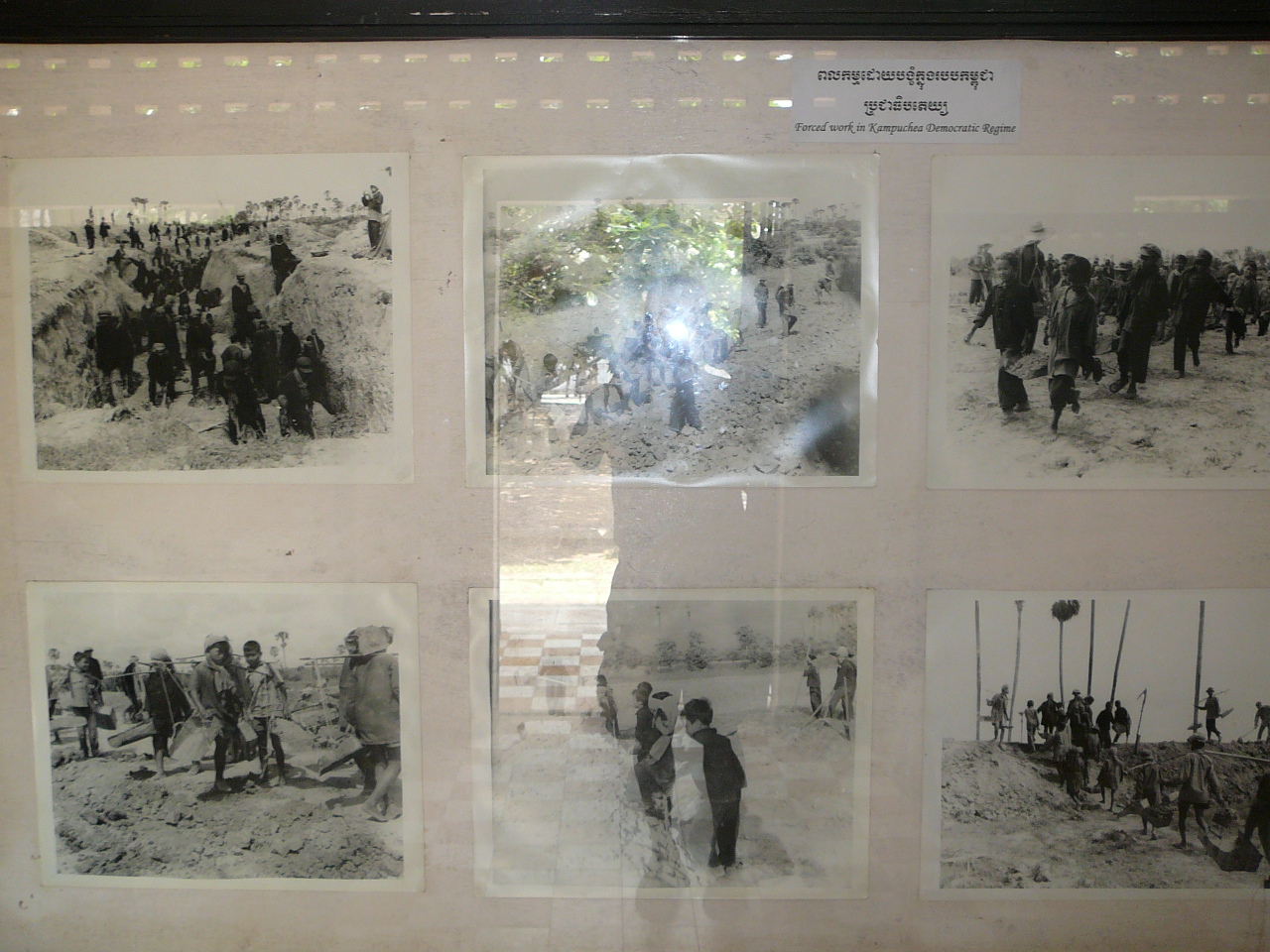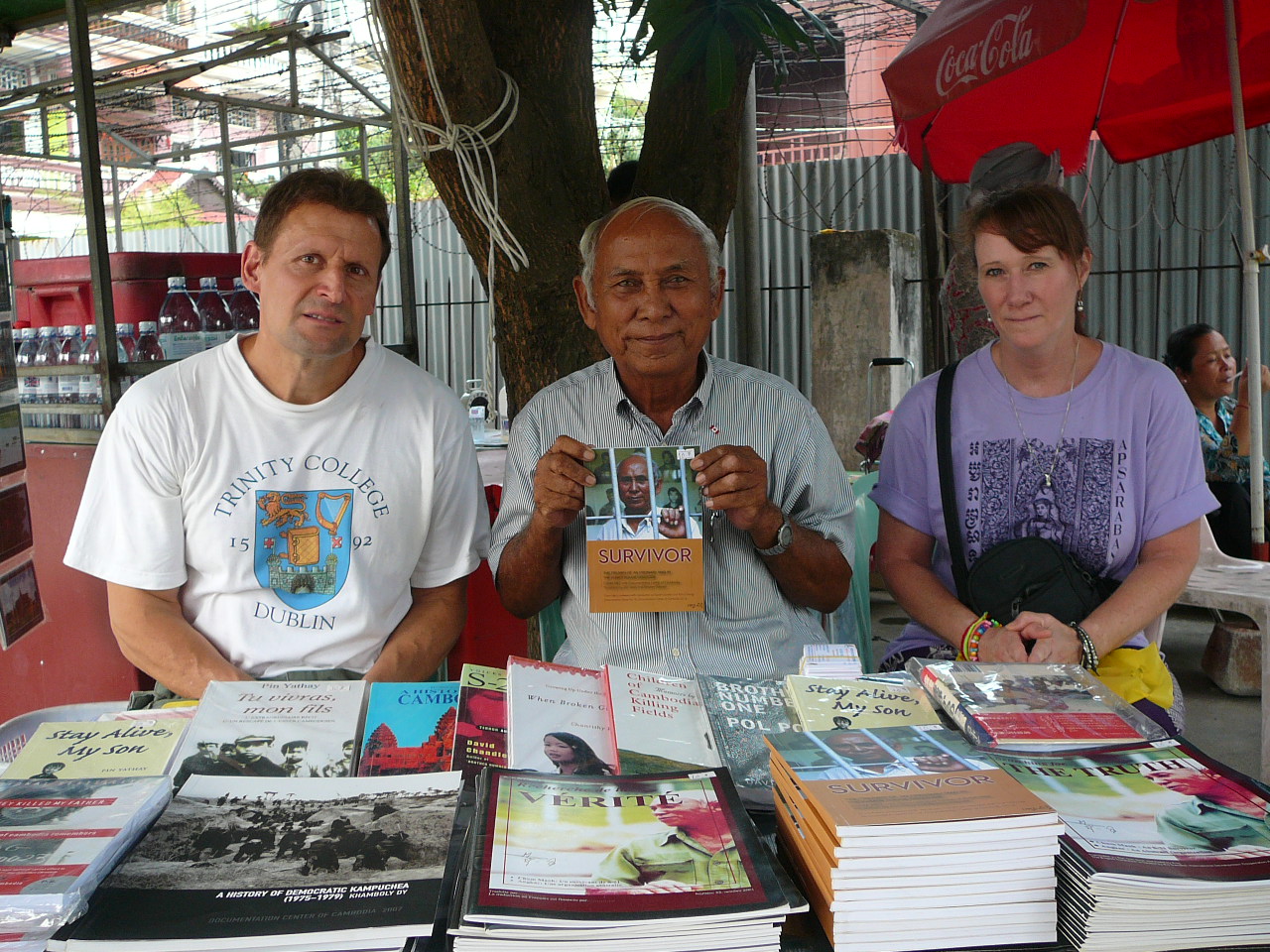On Monday in Phnom Penh, sufficiently recovered from Saturday's long bus ride, we decided we were ready for what we knew would be our most sobering experience in either South Africa or Cambodia. We visited the museum at the notorious prison of Tuol Sleng, and The Killing Fields of Choeung Ek.
Seeing these two places is essential for understanding the horrific atrocities suffered by Cambodians of that era. It makes you appreciate their amazing resilience. Some of the photos and descriptions later on in this blog entry are graphic and disturbing, but we eliminated many others that were even worse. Unfortunately, it's part of the story. If you don't want to feel depressed, feel free to skip these 2 blog entries.
Tuol Sleng, a former high school also known as S-21 (Security Prison 21), housed 17,000 prisoners between the time that the Khmer Rouge took over the country on April 17, 1975, and when Vietnamese forces ousted Pol Pot's regime in early 1979. Only 7 of these 17,000 people survived the experience.
 |
| Graves of the last 14 people killed at Tuol Sleng |
Pol Pot was one of the most brutal leaders the world has ever seen. During his 4 years in power, 1.7 - 3 million people Cambodians died, out of a total population of 8 million. The median estimate is ~ 25%. The Khmer Rouge was a Communist regime, although that was a secret not initially known to the people. Pol Pot's identity was also not known to most. The top leaders of the Khmer Rouge referred to themselves by number.
 |
| Pol Pot: Brother #1 and the face of pure evil |
Pol Pot ostensibly had a utopian vision of a peasant-dominated agrarian cooperative. He seemed to emulate the Cultural Revolution of Chairman Mao in China, only he was even more extreme. He committed genocide not for reasons of ethnic cleansing, but to eliminate all of the intellectuals, and later, out of sheer paranoia.
Within hours of riding their tanks into Phnom Penh, the Khmer Rouge started clearing out all of the cities and forcing people to migrate great distances to rural areas. All religious and educational institutions were shut down. Money and private property were abolished. The calendar was re-set to year zero. Everyone was required to dress in black pajama-like garments.
 |
| Map showing forced migration patterns of urban Cambodians |
The people were forced to work in the fields 14 hours a day, trying to meet unrealistic rice production quotas that had been tripled overnight. For food, they were given only a few spoonfuls by some accounts, or at most one bowl, of rice porridge a day. Many died from starvation.
 |
| Cambodians walked long distances and worked to death in the fields |
Those who were most threatening to Pol Pot were sent to prisons such as S-21, to be eventually executed. With the exception of the final 14 victims, who were brutally murdered just before the Vietnamese forces arrived in January 1979, the executions took place at The Killing Fields of Choeung Ek. Graphic photos of the final 14 victims are displayed at Tuol Sleng Museum on their former cell walls.
 |
| This is the state in which the final 14 victims were found |
 |
| An even more graphic photo, with the body in a state of decomposition |
Even though the formal executions were reserved for Choeung Ek, many prisoners died at S-21 of starvation, torture or other brutal treatment. Prison guards were recruited from among the ranks of poor peasant teenagers, who could be more easily controlled. The guards were told that if they didn't beat and torture the prisoners to the satisfaction of the prison officials, they would be killed themselves.
 |
| Faces of the prison guards at Tuol Sleng Museum |
In the photo above, Sarah is talking to our tour guide Sokha, who was around 10 years old in 1975. Sokha's father and 3 - 4 of her siblings died early in the Khmer Rouge regime, mostly from starvation and exhaustion. One may have been executed. Sokha's mother and 4 - 5 other siblings survived.
The family members were all forced to migrate in different directions. It took Sokha years of traveling around to different villages and asking "have you seen someone like this" questions to figure out where they were. And that was without the benefit of photographs, which all had to be destroyed under penalty of death.
Sokha has been giving these tours since 1990. For the first several years, she couldn't get through the tour without breaking down and crying. It is clear that she is still emotionally scarred today. But the good news is that her mother and the siblings who survived the Khmer Rouge years are all still alive today.
The Khmer Rouge extensively documented their atrocities. The prisoners were given numbered tags, whose shapes varied by year of arrival.
 |
| 4 different tags indicate they arrived in 4 different years, i.e. 1975 - 1978 |
 |
| These prisoners, who have identically shaped tags, all arrived in 1978 |
The prisoners were kept in tiny spaces, 11 cells to a room. They were shackled, and the doorway was open so the guards could easily see them. The cells were staggered so the prisoners looked across at brick walls, not other prisoners.
 |
| Typical prison cell at S-21 |
 |
| One of the cell blocks at S-21 |
The prisoners were subjected to horrible conditions, documented in photos by the prison:
 |
| Part of a much larger collage of ~ 40 photos |
 |
The starvation is evident in these photos of live prisoners
|
The prisoners included many of the Khmer Rouge's own ranks. Pol Pot's increasing paranoia caused him to purge many of his less extreme followers, particularly those stationed in the Eastern Zone near Vietnam. Many of them fled to Vietnam and were part of the 1979 invasion.
The final 21 prisoners at S-21 lasted that long because they had some photographic, artistic, mechanical or other skill that was of use to the prison staff. So the most gruesome post-death photos shown earlier in this blog entry are of the prisoners they had earlier treated the best. One of the 7 surviving prisoners was an artist, who after his release painted these pictures of prison conditions:
 |
| Painting documenting the horrible maltreatment |
 |
| Prisoner hung upside down at "the gallows" and dunked in water for forced confession |
 |
| Life in an S-21 prison cell |
The 7 survivors lived only because the prison staff didn't have time to kill them as the Vietnamese arrived in 1979. Of these seven, only two are still living today. We had the privilege to briefly meet one of them, Chum Mey, at the prison that day. We purchased his book "Survivor". Chum Mey was a mechanic, who repaired typewriters and other items for the prison staff. He is on the far left in the photo below:
 |
| The seven S-21 (Tuol Sleng) survivors, in 1979 |
 |
| Chum Mey (aka Chum Manh) looks great at age 81 |
Chum Mey has a remarkably positive attitude, given what he went through. He also has a genuine smile. In his book, he says he doesn't blame the young prison guards for what they did, since they were forced to torture prisoners or be killed themselves. He has given many interviews to foreign journalists, but we didn't ask him any questions since he had just woken up from a nap. We also didn't want to bother Sokha to be our interpreter.
We thanked Chum Mey for his graciousness. It was time to move on to the second part of the story, at The Killing Fields of Cheoung Ek.
Wow. I just have no idea what to say. It's a part of history I'm sad to say I haven't delved into much. I knew of Pol Pot, the intellectual purge, and the general numbers, but this brings it home. Congrats on going and learning. Just wow.
ReplyDeleteYes, it was a powerful experience. We were numb afterward, especially since we met people who were directly affected. We were glad we went. But we needed time to decompress.
Delete